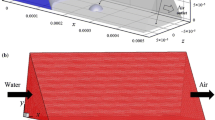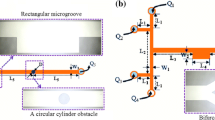Abstract
Microfluidic devices are of high efficiency for the coalescence and manipulation of monodispersed droplets. Numbers of microfluidic applications involve the control of droplets through networks of convergent or divergent junctions. The convergent microchannels are widely applied in transporting DNA and controlling other chemical and biological reactions. But there are still some problems unsolved such as that how to merge droplets more efficiently and how to guarantee the stability of the droplet in a convergent microchannel. In this work, numerical method is used to investigate the dynamic properties of the water microdroplets suspended in the convergent microchannel filled with oil. The moving of microdroplets in the convergent microchannel is driven by the initial droplet velocity. The surface tension is taken into account in the Navier-Stokes equations. The microchannel size parameter “Da” is firstly proposed to describe the convergent microchannel geometric characteristics and through which a regime map is created to classify droplets states into total coalescence regime, partial coalescence regime and no coalescence regime respectively. The dynamic behaviors of the droplets suspended in the convergent microchannel are discussed in detail. This work would contribute to the design of convergent microchannels for better biochemical analysis.
Similar content being viewed by others
References
Christopher, G.F. et al. Coalescence and splitting of confined droplets at microfluidic junctions. Lab Chip 9, 1102–1109 (2009).
Chokkalingam, V. et al. Optimized droplet-based microfluidics scheme for sol gel reactions. Lab Chip 10, 1700–1705 (2010).
Um, E. & Park, J.K. A microfluidic abacus channel for controlling the addition of droplets. Lab Chip 9, 207–212 (2009).
Teh, S.Y., Lin, R., Hung, L.H. & Lee, A.P. Droplet microfluidics. Lab Chip 8, 198–220 (2008).
Seemann, R., Brinkmann, M., Pfohl, T. & Herminghaus, S. Droplet based microfluidics. Rep. Prog. Phys. 75, 016601 (2012).
Tan, Y.C., Fisher, J.S., Lee, A.I., Cristini, V. & Lee, A.P. Design of microfluidic channel geometries for the control of droplet volume, chemical concentration, and sorting. Lab Chip 4, 292–298 (2004).
Jin, B.J. & Yoo, J.Y. Visualization of droplet merging in microchannels using micro-PIV. Exp. Fluids 52, 235–245 (2012).
Kuo, C.Y. & Pan, C. The effect of cross-section design of rectangular microchannels on convective steam condensation. J. Micromech. Microeng. 19, 035017 (2009).
Yobas, L., Martens, S., Ong, W.L. & Ranganathan, N. High-performance flow-focusing geometry for spontaneous generation of monodispersed droplets. Lab Chip 6, 1073–1079 (2006).
Köhler, J.M. et al. Digital reaction technology by micro segmented flow-components, concepts and applications. J. Chem. Eng. 101, 201–216 (2004).
Garstecki, P., Stone, H.A. & Whitesides, G.M. Mechanism for flow-rate controlled breakup in confined geometries: A route to monodisperse emulsions. Phys. Rev. Lett. 94, 164501 (2005).
Hung, L.H. et al. Alternating droplet generation and controlled dynamic droplet fusion in microfluidic device for CdS nanoparticle synthesis. Lab Chip 6, 174–178 (2006).
Tan, Y.C., Ho, Y.L. & Lee, A.P. Droplet coalescence by geometrically mediated flow in microfluidic channels. Microfluid Nanofluidics 3, 495–499 (2007).
Lee, D. & Weitz, D.A. Nonspherical colloidosomes with multiple compartments from double emulsions. Small 5, 1932–1935 (2009).
Li, J., Chen, H. & Stone, H.A. Breakup of double emulsion droplets in a tapered nozzle. Langmuir 27, 4324–4327 (2011).
Aubry, G. et al. A multicolor microfluidic droplet dye laser with single mode emission. Appl. Phys. Lett. 98, 111111–111111-3 (2011).
Chen, B., Guo, F. & Xiang, H. Visualization study of motion and deformation of red blood cells in a microchannel with straight, divergent and convergent sections. J. Biol. Phys. 37, 429–440 (2011).
Jose, B.M. & Cubaud, T. Droplet arrangement and coalescence in diverging/converging microchannels. Microfluid Nanofluidics 12, 687–696 (2012).
Chokkalingam, V. et al. Template free preparation of mesoporous silica spheres through optimized microfluidics. Chem. Phys. Chem. 11, 2091–2095 (2010).
Guo, M.T., Rotem, A., Heyman, J.A. & Weitz, D.A. Droplet microfluidics for high-throughput biological assays. Lab Chip 12, 2146–2155 (2012).
Leclerc, E., Kinoshita, H., Fujii, T. & Barthès-Biesel, D. Transient flow of microcapsules through convergent divergent microchannels. Microfluid Nanofluidics 12, 761–770 (2012).
Nguyen, H.B. & Chen, J.C. Effect of slippage on the thermocapillary migration of a small droplet. Biomicrofluidics 6, 012809 (2012).
Bashir, S., Rees, J.M. & Zimmerman, W.B. Simulations of microfluidic droplet formation using the twophase level set method. Chem. Eng. Sci. 66, 4733–4741 (2011).
Leng, C.A., Rowlinson, J.S. & Thompson, S.M. The gas-liquid surface of the penetrable sphere model. Proc. R. Soc. London, Ser. A 352, 1–23 (1976).
Olsson, E. & Kreiss, G. A conservative level set method for two phase flow. J. Comput. Phys. 210, 225–246 (2005).
Olsson, E., Kreiss, G. & Zahedi, S. A conservative level set method for two phase flow II. J. Comput. Phys. 225, 785–807 (2007).
Author information
Authors and Affiliations
Corresponding author
Rights and permissions
About this article
Cite this article
Yan, Y., Guo, D., Luo, J. et al. Numerical simulation of droplet dynamic behaviors in a convergent microchannel. BioChip J 7, 325–334 (2013). https://doi.org/10.1007/s13206-013-7403-5
Received:
Accepted:
Published:
Issue Date:
DOI: https://doi.org/10.1007/s13206-013-7403-5




